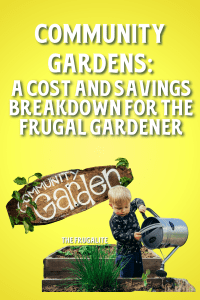(Psst: The FTC wants me to remind you that this website contains affiliate links. That means if you make a purchase from a link you click on, I might receive a small commission. This does not increase the price you’ll pay for that item nor does it decrease the awesomeness of the item. ~ Daisy)
By the author of the FREE online course Growing Self-Sufficiency: The Whole Picture
Out this way, we are seeing more and more signs that folks are feeling the squeeze when it comes to buying food. A local church has found that the fastest growing demographic of food bank users is…wait for it… double-income families with kids! Even a few years ago, this would have been unthinkable. I recently read an article in the national news written by a woman in a double-income family describing how even going grocery shopping had become an anxiety-producing experience.
One solution to the pressures we are all feeling in our pocketbooks is to come together and grow some food. I have participated in community gardens in a number of settings, including a small town, urban, and I have seen and/or had family members participating in others. I will share my perceptions of how participating in a community garden could save you money, versus starting a small plot on your own land.
Low to No Cost Membership
In my experience, community gardens vary in terms of whether they have a membership cost or not. However, when they do have one, I have never seen it be above $20. In the small town south of here, there is a membership fee, but that is waived for individuals and families in need. So, although you may have heard that there is a cost associated with a local community garden nearby, if you are on a very tight budget and you can speak with them, there could be a way to get your membership without the fee.
In other situations, I was successful at getting growing with an informal group. I once lived in an old building with six apartments. A few of us were interested in gardening and spoke to the owner about using a neglected flower bed on the west side of the building. We simply divided it in three and each took a piece. I grew a ton of food in a very small space there! We enjoyed being outside together and sharing the communal feel of our little plot.
Reduced Input Costs
For many of the community gardens that I have seen or participated in, you get a head start for free. In the previous example, the dirt was there, as was the brick border around the garden. If you don’t have a good rototiller, clearing even a small space of grass or sod for a garden is pretty back-breaking work!
In another community garden, we got an even further head start: We got our own raised bed, complete with a wood border and full of decent soil. As this group had done a good job of starting with good soil, I didn’t need to spend on a ton of soil amendments that year, either.
Most community gardens have a way to communicate with the group, whether that’s an email list or a social media group. If money is quite tight, you might have little money for your seeds. Even one packet of beans has more than most people need in a year. Early in the season, you could buy one packet of good bean seeds and see what you can swap for them. Many people who start seedlings always grow extra. By drawing on the resources of the group, you could be off to a great start and get seedlings and seeds by bartering with other things that you do have.
Some of our local libraries also offer seed banks, so you could look into that option.
Don’t Be a Tool: Borrow a Tool!
I don’t mind if some Frugalites disagree with me in the comments on this one, but I am through with buying any tools at dollar discount stores. Everything I have bought there for gardening, even a light small garden cultivator, has broken within a year or two. I am not someone who has tons of time to try and patch together broken $4 tools, and I can’t weld. Duct tape can only do so much!
I was recently responsible for drawing up a starting budget for our own local community garden. The bottom line: tools are really expensive! I’ve broken enough cheap tools over the years to know that some things are worth buying the best of. When I had a huge grading job to do around the foundation of my eco-cabin, I bought a shovel for $50. It was fantastic and will last me many more years.
The one community garden I joined in a smallish city of around 120,000 had a complete gardening toolbox, as well as watering cans, rain barrels, and composters already there. Each year, members paid a small deposit for their own key to the toolbox on sight. When you left, you got your key deposit back. As I lived in an urban apartment at that time with no storage, it was a great boost to not have to worry about a single tool for my community garden plot. In the time that I was there, the toolbox always had what I needed, even though there were often a few people working on their plots at the same time.
The Benefits of Many Hands
If you live in a home or even an apartment and plan to go away during the gardening season, you may need to pay someone to come and water your garden while you are away, especially if you use containers. At the community

Other tasks, like spring set up, fall clean up, or managing a large compost pile, can be accomplished much more easily during a “working bee” half day. I always enjoyed the community spirit created by working on a shared goal, especially when that goal was growing healthy food!
Free Advice and Expertise
It can be an education just to walk around a community garden and see how everyone does things in their own box. As I was less experienced when I was in the urban community garden, I used to enjoy walking around and seeing what people were doing and how their vegetables were growing. If there was a particularly well-kept box, I kept my eye out for those owners so that I could ask a few questions.
Everyone loved talking about what they were doing, and I learned a great deal that way! This kind of mentorship can save you both time and money: if your garden has a problem, getting good advice from an experienced gardener could save your harvest and all your invested time and money thus far. You can also substantially shorten your learning curve, saving time and money, by drawing on experienced gardeners to improve your harvest.
Get Growing with a Community Garden
Even if your long-term vision is a self-sufficient homestead in the isolated wilds, joining a community garden could be a money-saving stepping stone in that direction. Could you see yourself trying out a community garden in the near future? Do you have your own favorite money-saving benefit of community gardening you can share with us? Please tell us in the comments below.
About Colette
Colette is passionate about sharing her knowledge of thrifty living and self-sufficiency. She has developed her skills in self-reliance living in the suburbs, the city, and more recently, on her own Half-Acre Homestead. Colette lived five years completely off-grid and without running water in an eight by 24 foot tiny home while designing and building her own 18 by 24-foot eco-cabin. Her website, Half Acre Homestead is attracting followers from around the world who want to become more self-sufficient. Colette invites you to stop by the Homestead and check out all of the great resources including the practical How To Guides, A Tiny Home Resource Center and her organic gardening stories on her blog. She shares her wholistic model (body/mind/spirit) for achieving self-sufficiency in her Free Course, “Growing Self-Sufficiency: The Whole Picture.” Stop by the Homestead today to register free of charge!











11 thoughts on “Community Gardens: A Cost and Savings Breakdown for the Frugal Gardener”
I have had a community plot for the last 6 years and am starting my 7th season last week. It’s 220 square feet of paradise. I grow in it around 20% of my food every year. Through the same Nonprofit group, I also have a CSA farm share that produces 50% of my food every year. The way they are set up here in my city of 85,000 the CSA’s (Community Supported Agriculture) donate half of their crops to the local foodbank network. Now my garden plot rent is $60 a season and my CSA is a bit higher at $400 a year but saves me money to buy what I can’t grow. The garden all tools are in the shed for our use and they supply them, water, fertilizer, compost, even left over seedlings from the small farm for us to plant. The time being outdoors, watching the wonders of nature, meeting and making friends from all over my little city has no price. All the 4 CSA’s in the group have a flower section that help attract the bee’s but we also get to cut flowers during the season so once a week I can get a fresh bouquet.
Hi Everette, Thanks for sharing your details about your “220 square feet of paradise”! It is helpful to have others share the logistics and price of community gardens. Combining that with a CSA: what a great way to go! Enjoy the coming season and may it be plentiful for you!
We also have been part of a community garden run by the Knights of Columbus. We have one plot that is 20×40 and another that is 20×10. The smaller one is where I grow our medicinal herbs and flowers and the larger one is for veggies. Cost is $100 a year which includes water, and it’s great to be there and talk to others and find out what works for them None of us has ever had success with peppers. 🙂 A few years ago I harvested around 300 lbs of tomatoes and last year I canned 64 pints of beans, not to mention the glut of squash. Asparagus is in it’s second year. Haven’t had much luck with onions though. Love my garden and hubby and I go there almost every evening in the height of summer.
Hi Kate, Oh WOW! 300 pounds of tomatoes!!!! Very curious about your beans: were they pickled green beans? pinto beans in tomato sauce? I also enjoy medicinal herbs. I just went out to put a muck bucket over my Motherwort, which has come back stronger than ever this spring. We’ll have two nights of frost and then I think I’m in the clear. Like you, I enjoy the time spent in my garden. However, here, if I went out in the evening, I would be eaten ALIVE by mosquitos. I’m happy for you that you can enjoy the peace of the garden in the evening. Wishing you a great harvest this year!
Hi Colette…..sorry for the late reply. I just pressure canned most of the green and yellow beans. A few jars I pickled. We’re very lucky here in that we only see about 2 or 3 skeeters in the summer. Wonder if it’s because we’re about 5 minutes away from the ocean. When we lived in the Kootenay’s right by Kootenay Lake there were swarms I swear were miles across. We decided this year to only plant half of our large plot and leave the other half fallow, and maybe grow a cover crop?? Have to look into that. For some reason my 5 blueberry plants didn’t make it, and neither did my huge lavender bush or the Rosemary and it wasn’t even that cold this winter. Rats. The Peony’s are all coming up and I think my Stevia survived. Enjoy your garden.
Hi Kate, Thanks for letting me know about the beans. That’s helpful. Sorry to hear that some of your plants didn’t make it. Same thing happened to me with my lavender bush a couple years ago. I’m trying again with a new one. Thanks for reminding me about my peony: shoots are up and I need to go give it a bit of compost for a boost. Wishing you a great gardening season, Kate. Thanks again!
food stamps SNAP covers seeds .
also the rules allow swapping covered items with another person, at equal value. i asked about it.
so i can swap you a loaf of bread for seeds you buy and this is ok with them😎
don’t remember about food plants buy i never saw them where SNAP was taken.
https://www.fns.usda.gov/snap/eligible-food-items
What Can SNAP Buy?
Any food for the household, such as:
Fruits and vegetables;
Meat, poultry, and fish;
Dairy products;
Breads and cereals;
Other foods such as snack foods and non-alcoholic beverages; and
Seeds and plants, which produce food for the household to eat.
That is helpful to know that SNAP could help cover seeds and plants. That is certainly money that would harvest many times its value in produce. Thanks so much for sharing!
Collete,
Try buying old made-in-USA garden tools at estate sales. Those are unlikely to ever break! If you wait until the last day of an estate sale, the items will usually be half price (and you can try negotiating to get an even better deal). Go out to the garage or tool shed to look for shovels, rakes, hoes, etc. that the estate is selling. Older people who are downsizing may have a garage sale or moving sale and you could snap up their older sturdy tools there. Another good place to find garden tools would be at a Habitat Re-Store or another thrift store, particularly if said store specializes in tools and hardware-type items.
Hi Fru-gal Lisa, Thank you so much! These are all great suggestions. We are having our first meeting tonight for our new community garden, and I’ll mention these are a great idea. We have applied for some funding, but won’t find out for weeks….kind of awkward timing for starting, for sure! The next time I’m in a larger city, I will be sure to stop in at our local Habitat Restore to have a look. I agree…made-in-USA tools of a good vintage would likely last forever. Thanks again!